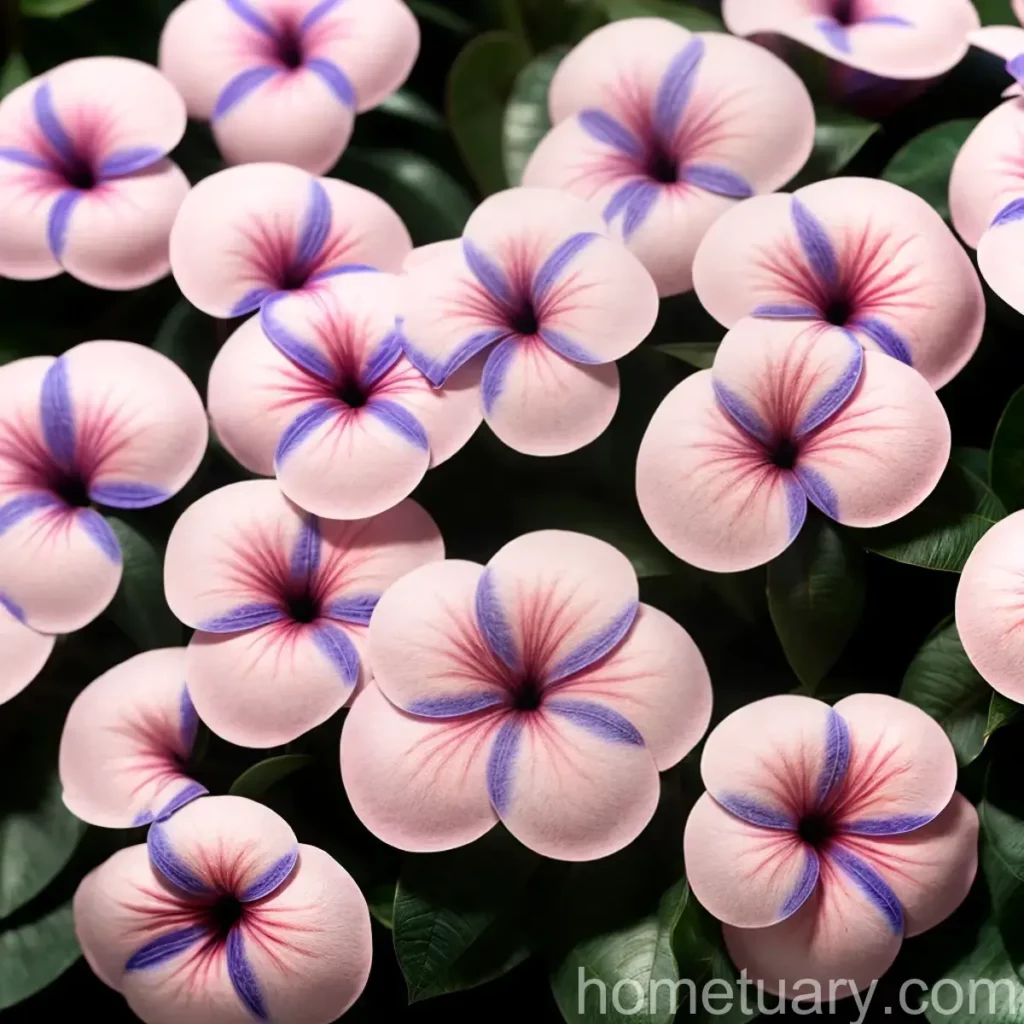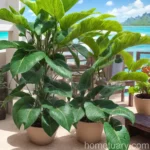The Beauty and Care of Madagascar Periwinkle (Catharanthus roseus)
The Madagascar periwinkle, scientifically known as Catharanthus roseus, is a stunning and versatile flowering plant. This plant offers a spectrum of vibrant colors and is renowned for its numerous medicinal properties. In this article, we will delve into the world of the Madagascar periwinkle, exploring its characteristics, cultivation, uses, and how to care for it.
What is the Madagascar Periwinkle (Catharanthus roseus)?
The Madagascar periwinkle, also called Vinca rosea, rosy periwinkle, or annual vinca, is a species of flowering plant in the dogbane family, Apocynaceae. Native to Madagascar, this plant has gained widespread popularity as an ornamental and medicinal plant worldwide. It is known for its glossy green foliage and an array of phlox-like flowers that bloom abundantly.
Plant Information:
– Scientific Name: Catharanthus roseus
– Common Names: Madagascar periwinkle, Vinca rosea, rosy periwinkle, annual vinca
– Family: Apocynaceae
– Native Habitat: Madagascar
– Plant Type: Perennial in its native habitat, but commonly grown as an annual in temperate regions
– Growth Habit: Low-growing, spreading, and densely branched
Key Takeaways – Madagascar Periwinkle (Catharanthus roseus)
- Botanical Name: Catharanthus roseus
- Family: Apocynaceae
- Common Names: Madagascar periwinkle, Vinca rosea, rosy periwinkle, annual vinca
- Native Habitat: Madagascar
- Plant Type: Perennial (grown as an annual in temperate regions)
- Growth Habit: Low-growing, spreading, and densely branched
Culture
The Madagascar periwinkle has a rich cultural significance and finds its place in traditional medicine, gardening, and landscaping. It holds value in various cultures for its therapeutic properties and aesthetic appeal. Let’s navigate through the uses and cultural significance of this plant.
Uses
The Madagascar periwinkle has a wide array of uses, ranging from traditional medicine to ornamental purposes.
Medicinal Uses:
– The plant contains alkaloids such as vinblastine and vincristine, which are vital in the treatment of numerous types of cancer.
– In traditional medicine, extracts from the plant are used to treat diabetes, high blood pressure, and wasp stings. Additionally, it is utilized as a diuretic and an astringent.
Ornamental Purposes:
– Its dazzling and persistent blooms make it a popular choice for ornamental plantings in gardens, landscapes, and containers.
Cultural Significance:
– In several cultures, the Madagascar periwinkle is associated with notions of spirituality, purity, and positivity, and is often used in religious ceremonies and rituals.
Care
Proper care is essential for the Madagascar periwinkle to thrive and display its full splendor. This includes considerations for water, sunlight, fertilizer, soil, pruning, propagation, and potential cultivation in containers. Let’s explore each aspect of care to understand how to best nurture this remarkable plant.
Water
Watering Requirements:
– Madagascar periwinkle plants prefer consistently moist soil, especially during their active growing season.
Watering Tips:
– Ensure the soil is well-draining to prevent waterlogging, which can lead to root rot.
– Water the plants at the base to avoid wetting the foliage, as this can make them susceptible to diseases.
Sunlight
Sun Exposure:
– Madagascar periwinkles thrive in full sun to partial shade. They typically require at least six hours of direct sunlight per day for optimal growth and blooming.
Sunlight Tips:
– In hot climates, providing them with some afternoon shade can help protect them from intense heat.
Fertilizer
Fertilization Guidelines:
– Use a balanced, all-purpose fertilizer to promote healthy growth and prolific flowering.
– Apply a slow-release fertilizer at the beginning of the growing season to provide essential nutrients over an extended period.
Fertilizing tips:
– Avoid over-fertilization, as this can lead to excessive foliage growth at the expense of flowers.
Soil
Soil Requirements:
– Madagascar periwinkle plants thrive in well-draining, fertile soil with a slightly acidic to neutral pH (6.0 to 7.5).
Soil Tips:
– Incorporate organic matter such as compost into the soil to improve its structure and fertility.
Pruning
Pruning Techniques:
– Regular deadheading, the removal of spent flowers, encourages continuous blooming and prevents the plant from setting seeds prematurely.
Pruning Tips:
– Use clean, sharp pruners to make precise cuts without causing damage to the plant.
Propagation
Propagation Methods:
– Madagascar periwinkles can be propagated from seeds, cuttings, or division of mature plants.
– Seeds can be sown directly in the garden or started indoors for early blooms.
Propagation Tips:
– Take cuttings from healthy, disease-free plants, and ensure the cuttings have at least two sets of leaves to improve their chances of successful rooting.
Container Cultivation
Container Planting:
– Madagascar periwinkles are well-suited for container gardening, where they can be grown in pots, hanging baskets, or window boxes.
Container Tips:
– Choose a container with adequate drainage holes to prevent waterlogging.
– Use a high-quality potting mix that provides good aeration and drainage.
Popularity
Madagascar periwinkle enjoys widespread popularity as a garden and landscape plant, owing to its captivating flowers and low-maintenance nature. Its versatile uses make it a valuable addition to various settings. The plant’s popularity is evident in its frequent appearance in gardens, parks, and as a subject in horticultural endeavors.
Common Diseases
Despite its robust nature, the Madagascar periwinkle is susceptible to certain diseases. Below are some common diseases that can affect this plant, along with tips on diagnosis and management.
Disease Diagnosis
Disease: Phytophthora Root Rot
– Symptoms: Wilting, yellowing leaves, and stunted growth are indicative of root rot.
– Diagnosis: Carefully dig up the affected plant and inspect the roots for signs of rotting or decay.
– Management: Improve drainage, avoid overwatering, and remove and destroy severely affected plants.
Disease: Powdery Mildew
– Symptoms: A white, powdery growth on the leaves and stems suggests powdery mildew infection.
– Diagnosis: Characteristic powdery patches and distorted foliage aid in identifying the disease.
– Management: Prune affected parts, ensure good air circulation, and apply fungicidal sprays if necessary.
Disease: Leaf Spot
– Symptoms: Circular, dark spots on the leaves, often bordered by a yellow halo, are indicative of leaf spot diseases.
– Diagnosis: The appearance of lesions and subsequent leaf yellowing aid in diagnosis.
– Management: Remove and destroy affected leaves, avoid overhead irrigation, and apply fungicidal treatments if needed.
Common Pests
Madagascar periwinkle is also vulnerable to pest infestations, which can compromise its health and appearance. Familiarizing oneself with potential pests and employing suitable control measures is crucial for preserving the plant’s vitality.
Pests: Aphids
– Identification: Small, soft-bodied insects clustered on the tender shoots and undersides of leaves.
– Control: Hose off aphids with a strong stream of water or use insecticidal soap for severe infestations.
Pests: Spider Mites
– Identification: Fine webbing on the plant, stippled or yellowing leaves, and a decrease in plant vigor indicate spider mite presence.
– Control: Utilize miticides, maintain proper humidity levels, and regularly wash the plant to deter mites.
Pests: Whiteflies
– Identification: White, fly-like insects rising in clouds when the plant is disturbed are a sign of whitefly infestation.
– Control: Introduce natural predators like ladybugs, use sticky traps, or apply neem oil to manage whiteflies.
Botanist’s Tips
As a plant scientist, I offer the following insights and tips for growing and caring for Madagascar periwinkle:
-
Selecting Varieties: Explore different varieties of Madagascar periwinkle to introduce a range of flower colors and growth habits in your garden or landscape.
-
Soil Improvement: Incorporate organic matter such as compost or well-rotted manure into the soil to enrich its fertility and structure.
-
Integrated Pest Management (IPM): Embrace an IPM approach and prioritize cultural and biological control measures to manage pest issues sustainably.
-
Companion Planting: Consider planting aromatic herbs or insect-repellent plants near Madagascar periwinkle to deter pests and attract beneficial insects.
Fun Facts
Here are some intriguing and delightful facts about the Madagascar periwinkle:
-
The plant’s vibrant flowers attract bees, butterflies, and other pollinators, contributing to the ecosystem’s biodiversity.
-
Madagascar periwinkle has been the subject of extensive scientific research due to the discovery of valuable alkaloids with medicinal properties.
-
Its adaptability makes it a favorite choice for novice and experienced gardeners alike, as it thrives in various conditions with minimal care.
Links to External Resources
For further information on the Madagascar periwinkle, its cultivation, and uses, explore the following resources:
-
Plant Pathology Guidelines for Managing Diseases in Ornamentals
-
Integrated Pest Management Strategies for Horticultural Crops
In conclusion, the Madagascar periwinkle, with its captivating flowers and medicinal significance, is a remarkable plant that offers a multitude of benefits to gardeners, horticulturists, and health enthusiasts. Understanding its care requirements and embracing its cultural and ecological significance can enhance the overall gardening and horticultural experience. Whether grown for its ornamental allure or medicinal value, the Madagascar periwinkle continues to captivate individuals with its beauty and utility.















